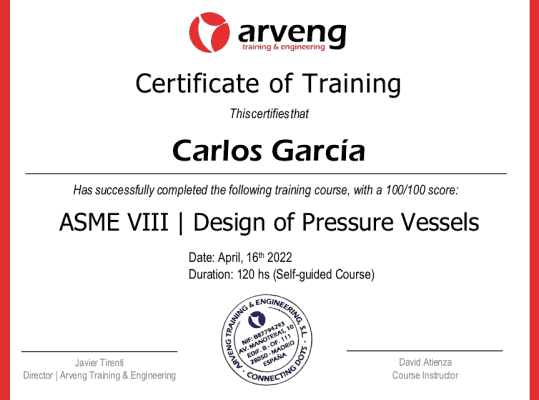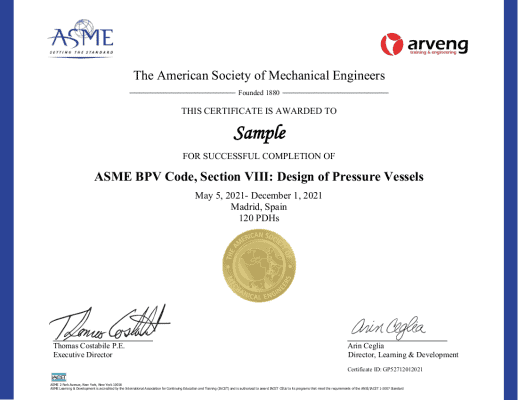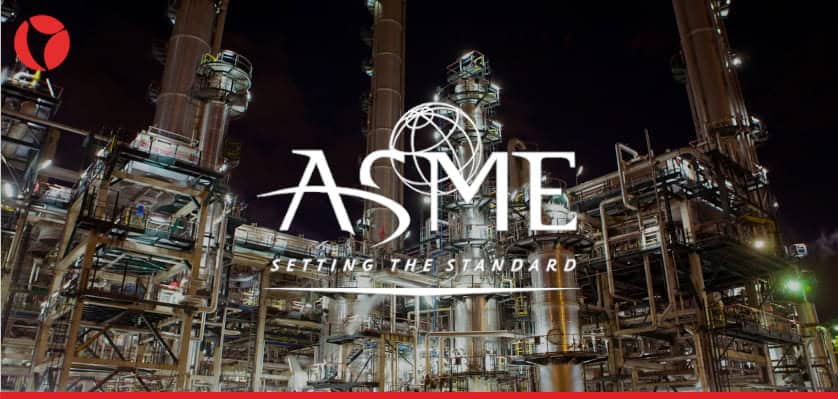Design of mechanical equipment (Self-guided)
| 514 Students |
| Duration: 240 hours |
| Lectures: Available! |
| Video: English |
| Certificate of Training |
In this course you will learn......
+ The the organization of the codes, vocabulary and fundamentals.
+ The knowledge for design of the main mechanical equipment used in most industrial plants, safe an economical.
WITH THE ACCESS TO THE COURSE YOU GET:
Course access: 12 months
This level has been developed to be completed in 6 months. However, the campus will be open 12 months to give you more time.
Consultation forum
Queries will be channeled via dedicated forums, our instructors will answer as soon as possible!
Instructor available
An specialist Instructor will be available throughout the entire duration of the course.
Downloadable resources
Study notes, case studies and extra material are downloadable for future reference.
Summary videos
Each lesson includes a summary video with then fundamental concepts dealt with in that lesson for better understanding.
Lesson included
All the lessons indicated in the CONTENTS tab are included.
Assessment questions
Multiple-choice assimilation questions and cases are presented in each lesson to fix fundamental concepts.
Case studies
This is a “hands-on” course. Real cases (and solved) are presented to be developed with the course material.
Calculation sheets
Specific spreadsheets have been developed to simplify the calculation process. Calc sheets are downloadable.
Certificate of approval
A certificate of approval issued by ARVENG or ASME (your choice) will be submitted upon completion.
FREQUENTLY ASKED QUESTIONS (FAQ’s):
How can I enroll in this course?
To enroll in this course you have to follow the below steps:
- Choose the course you need from the drop-down menu (top right hand corner of the web).
- Click on “Add to cart”
- Complete the purchase process using the payment options available.
- You will receive a confirmation email.
- Start training your skills!
Can I register and pay an online course for a 3rd party/more than one person?
To enroll a 3rd paty/more than one person you have to follow the below steps:
- Change the number of products of your cart (1 by default):
a. Change the number of products before clicking on “Add to Cart”.
b. Directly on the cart screen, there is a button where you can increase or decrease the amount of products to buy. - State the Name and Surname of the participants in the observations field when completing the purchase.
Are there discounts for groups/companies?
Yes! Contact us indicating your needs and we will find the most convenient alternative for you.
COURSE LED BY AN ASME AUTHORIZED INSTRUCTOR
You can study the structure, contents and methodology before enrolling.
Pay for this course in three interest-free installments with PayPal. More information.
Begin at your convenience, progress at your own time and own pace.
The course follows the “learn by doing” methodology. Different challenges are presented in the form of practical case studies. With the help of the Study Notes and with the assistance of the instructor, participants will progress gradually throughout the course.
Who should attend?
This course is intended for graduates (or soon to be), designers, freelancers, technicians and engineers involved in: calculation, design, selection, manufacturing, safety, quality and maintenance of systems and equipment in industrial processes.
Previous knowledge of this subject is not required to attend to the course.
Training objetives
The main objective of this course is to transfer to participants the theoretical and practical skills required in projects, obtained from experience and sound engineering practices.
What to expect?
Course participants will gain the knowledge for design of the main mechanical equipment used in most industrial plants, safe an economical.
At the end of the course, participants will be able to design the main parts of the mechanical equipment proposed.
- Know the organization of the codes and acquire the vocabulary and fundamentals.
- Benefit from the lessons learned and best engineering practices.
- Learn to select materials.
- Define the fluid velocity and obtain the min. diameter for a pipe and a known flow.
- Select the different components of a piping system.
- Calculate the required thickness of the pipe under internal pressure.
- Design and calculate stiffening rings for a pipe under vacuum.
- Learn to perform stress and flexibility analysis on systems using simplified methods.
- Calculate buried piping systems.
- Become familiar with the basics of a pipe layout.
- Learn to interconnect pipes with the main equipment.
- Understand the main differences between the types of supports.
- Learn to select rigid and spring supports.
- Learn to design and calculate the main parts of a pressure vessel.
- Understand and apply the Joint Efficiency concept.
- Learn to deisign Legs, Skirs and Saddles.
- Define the wind profile and seismic loads.
- Design and calculate stiffening rings for a pressure vessel under vacuum.
- Learn to design different types of nozzles: built up, self-reinforced, integral.
- Learn to design Non-Standard Flanges.
- Understand the different configurations of Heat Exchangers.
- Learn to design a heat exchanger from a mechanical point of view.
- Design the tube bundle and calculate the thickness of the tubesheet.
- Learn to verify the thickness of the transfer tubes.
- Learn to design and calculate the main parts of a storage tank.
- Design and calculate stiffening rings for the tank wall.
- Define the anchorage requirements due to earthquake and the wind.
- Understand the main differences between roof types.
- Learn to design and calculate fixed roofs and their internal support structure.
- Obtain the seismic spectrum, wind loads and verify the overturning moment.
- Design anchor bolts of static equipment due to combined loads.
TRY THIS COURSE BEFORE ENROLLING!
You can study the structure, contents and methodology before enrolling. You can also watch the introductory videos and solve the test in Lesson 1! Leave us your contact information and we will send the instructions to access the Virtual Campus:
CONTENTS AND STRUCTURE OF THE COURSE: 240 HS
PART I (120 hs):
Classification & Characteristics
Design Conditions
Load Types | Pressure | Wind | Seismic
Material Selection
Corrosion Types | Materials Designation
Proposed Case Studies
- Self-Assessment Quiz: Multiple choice questions
Divisions | Organization | Scope
Piping Specification
Piping | Fittings | Piping Class
Thickness Calculations
ASME B31 Equations | Available Thicknesses
Piping Layout
Plot Plan | Equipment Location
Stress & Flexibility Assessment
Thermal Loads | Simplified Calculations
Proposed Case Studies
- Self-Assessment Quiz: Multiple choice questions
- Case Study: Thicknesses Calculation
Divisions | Organization | Scope
Joint Efficiency
Joint Category | Efficiency Values
Internal Pressure Design
Shell | Heads | Conical Transitions
External Pressure Design
Support Lines
Stiffening Rings
Proposed Case Studies
- Self-Assessment Quiz: Multiple choice questions
- Case Study: Internal Pressure Design
Divisions | Organization | Scope
S&T Heat Exchangers Configurations
Tubes Arrangement | Number of Passes
Shell Design
Cylindrical Shells | Types of Heads
Tube Bundle Design
Tubesheet | Bundle Structure | Joining Methods
Proposed Case Studies
- Self-Assessment Quiz: Multiple choice questions
- Case Study: Tubesheet & Tubes Design
Divisions | Organization | Scope
Tank Shell Design
One-Foot Method | Fabrication Requirements
Tank Bottom Design
Plates Distribution | Annular Plate
Fixed Roof Design
Roof Types | Configuration | Thicknesses
Proposed Case Studies
- Self-Assessment Quiz: Multiple choice questions
- Case Study: Design of Tank Shell & Bottom
PART II (120 hs):
Fluid Flow | Energy Conservation principle
External Pressure Design
Support Lines | Stiffening Rings
Design of Buried Piping
Types of Loads | Stresses Verification
Equipment Interconnection
Layout Importance | Good Practices
Supports Design
Location | Supports Selection
Proposed Case Studies
- Self-Assessment Quiz: Multiple choice questions
- Case Study: Optimal Diameter & Pressure Loss
Trays | Supports
Lifting Lugs
Nozzle Design
Flange Selection | Nozzle Neck | Reinforcement Pads
Wind & Seismic Loads
Vessel Loads | Vibration Period
Supports for Vertical Equipment
Design of Legs & Skirts | Anchor Bolts
Proposed Case Studies
- Self-Assessment Quiz: Multiple choice questions
- Case Study: Nozzle Design
Hub Design | Calculation Procedures
Design of Body Flanges (Non-Standard)
Design Sequence | Sound Practices
Supports for Horizontal Equipment
Design of Saddles | Anchor Bolts
Proposed Case Studies
- Self-Assessment Quiz: Multiple choice questions
- Case Study: Design of Body Flanges (Non-Std)
Shell Stability | Wind Girders
External Pressure
Design considerations | External pressure verification |
Tank Shell verification
Nozzle Design
Configuration | API 650 Code Requirements
Wind Loads
Wind Pressure on the Shell | Overturning Moment
Seismic Loads
Base Shear | Overturning Moment
Anchor Bolts
Number of Bolts | Chairs Design
Proposed Case Studies
- Self-Assessment Quiz: Multiple choice questions
- Case Study: Nozzle Design
TRY THIS COURSE BEFORE ENROLLING!
You can study the structure, contents and methodology before enrolling. You can also watch the introductory videos and solve the test in Lesson 1! Leave us your contact information and we will send the instructions to access the Virtual Campus:
EXAMPLE OF A CERTIFICATE ISSUED BY ARVENG:

EXAMPLE OF A CERTIFICATE ISSUED BY ASME:

Upon successful completion of the course participants will earn 240 PDH’s, equivalent to 24 CEU’s.
This recognition can only be obtained with the ASME certificate.
PDH: Professional Development Hour
CEU: Continuing Education Unit
REQUEST MORE INFORMATION!
Please send us your query and we will reply as soon as possible.
About Instructors

Reviews
Average Rating
Detailed Rating
| Stars 5 |
|
14 |
| Stars 4 |
|
6 |
| Stars 3 |
|
0 |
| Stars 2 |
|
0 |
| Stars 1 |
|
0 |
Add a review Cancel reply
You must be logged in to post a review.
| 514 Students |
| Duration: 240 hours |
| Lectures: Available! |
| Video: English |
| Certificate of Training |



 WhatsApp
WhatsApp
Emilia C.
A pleasant experience in addition to learning new things that will be useful to us in the exercise of our profession.
Susan S.
I highlight the continuous attention on the part of the tutor when it comes to resolving doubts. Complete course and very clear when it comes to following it.
Alexander T.
The content is very broad and the explanations are very detailed. I recommend it.
Harrison A.
Clear, precise and highly topical training in the practical examples it offers.
Jane U.
The tutor’s attention has been very good, the operation of the platform is excellent, as well as the clarity and material provided in the course. I recommend it.
Richard A.
Very practical course adapted to initial objectives. 100% recommended.
Lewis H.
The experience has been totally satisfactory, the structure, duration and scope are appropriate.
Hakan G.
Overall, this course was very helpful and I really appreciate your help and support. It helped me out to remind some details, learning some more details and making practice for some topics. Thanks to everyone who has a part of this fruitful course.
richardbf
I’d like this course to be more comprehensive on some topics, but I guess I will have to enroll on other courses to keep learning about them. Good course, anyway.
Megan
I like the structure of this course, and the fact that you can complete it by modules at your own pace.
George H
A lot of exercises to practice all the theory in this course… It’s a very complete course.
amy
Very good course. I am looking forward to go deep in some concepts with another Arveng courses.
PaulAnd
My first time following an online course… And I’ll repeat for sure! Lots of materials to practice each lesson.
S.Bruce
Great course, teacher’s responses a fast and comprehensive.
joe-curbs
I’m brand new to this field and the course have helped me a great deal. Even when this is a tough subject, the structure and assignments allow you to go step by stop at your own pace. Thanks to the Arveng team.
kevin.francis
Very good course. Arid topics, very well broken down. Arveng Admin has been really flexible with me, thanks! Kevin.
fabiofidaro
Very comprehensive course. It coveres a lot of equipments, designs and configurations. Real data sheets and case sutides are the added value of this course. I recommend this course 100%.
susan.dobson
Excellent course! Will repeat for sure. Thanx.
ed-harrys
Loved the structure of the course, even better assignments. This is trully a self-guided course, course very easy to follow. Ed
patrick.ilja
Great compilation of design requirements for the main mechanical equipment in a plant. I was surprised by the promptness of the instructor and elaborated responses. Will recommend this course for sure.